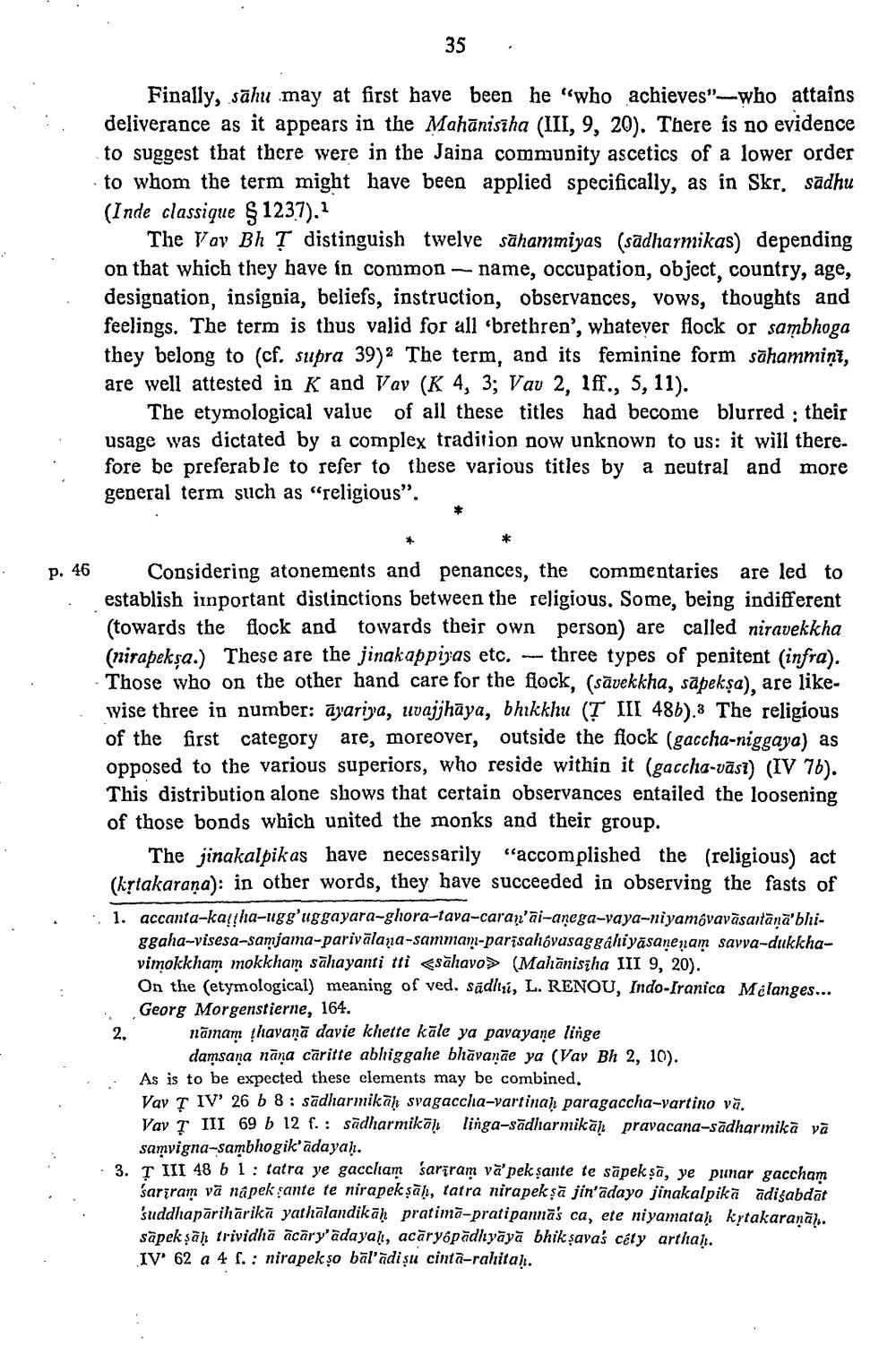________________
35
.
Finally, sāhu may at first have been he "who achieves"-who attains deliverance as it appears in the Mahānisīha (III, 9, 20). There is no evidence to suggest that there were in the Jaina community ascetics of a lower order to whom the term might have been applied specifically, as in Skr. sādhu (Inde classique § 1237).1
The Vay Bh ? distinguish twelve sähammiyas (sadharmikas) depending on that which they have in common name, occupation, object, country, age, designation, insignia, beliefs, instruction, observances, vows, thoughts and feelings. The term is thus valid for all brethren', whatever flock or sambhoga they belong to (cf. supra 39)2 The term, and its feminine form sāhammiņi, are well attested in K and Vav (K 4, 3; Vav 2, iff., 5, 11).
The etymological value of all these titles had become blurred; their usage was dictated by a complex tradition now unknown to us: it will there. fore be preferable to refer to these various titles by a neutral and more general term such as "religious".
p. 46 Considering atonements and penances, the commentaries are led to . establish inportant distinctions between the religious. Some, being indifferent
(towards the flock and towards their own person) are called niravekkha (nirapeksa.) These are the jinakappijas etc. -- three types of penitent (infra). Those who on the other hand care for the flock, (sävekkha, sāpeksa), are likewise three in number: āyariya, uvajjhāya, bhikkhu (T III 486).3 The religious of the first category are, moreover, outside the fiock (gaccha-niggaya) as opposed to the various superiors, who reside within it (gaccha-vāsi) (IV 76). This distribution alone shows that certain observances entailed the loosening of those bonds which united the monks and their group.
The jinakalpikas have necessarily "accomplished the religious) act (kytakaraņa): in other words, they have succeeded in observing the fasts of 1. accanta-katha-ugg'uggayara-ghora-tava-caran'āi-anega-vaya-niyamovavāsaitānā'bhi
ggaha-visesa-samjama-parivālana-sammam-parisalóvasaggahiyasanenam savva-dukkhavimokkham mokkham sāhayanti tti <sāhavo> (Mahānisiha III 9, 20). On the (etymological) meaning of ved. Sadlui, L. RENOU, Indo-Iranica Mélanges...
Georg Morgenstierne, 164. 2. nāmam thavaņā davie khette kāle ya pavayane linge
damsana nāna caritte abhiggahe blāvanāe ya (Vay Bh 2, 10). .. As is to be expected these elements may be combined.
Vav T IV 26 b 8: sādharmikan svagaccha-vartinah paragaccha-vartino vā. Vay T III 69 b 12 f. : sādharmikali linga-sādharmikāh pravacana-sādharmikā vā
samvigna-sambhogik'ādayah. . 3. T III 48 b 1: tatra ye gacclam sariram vă'pek şante te sāpek şa, ye punar gaccham
sariram va napek gante te nirapek şan, tatra nirapek şā jin'ādayo jinakalpikā adisabdāt suddha pārinārika yathalandikāh pratima-prati panna's ca, ete ni yamatak kytakaranah. sāpek şah trividhā ācāry'adayalı, acāryopādlıyāyā bhik savas cély arthal. IV 62 a 4 f. : nirapekso bāl'ādi şu cinta-rahitah.




